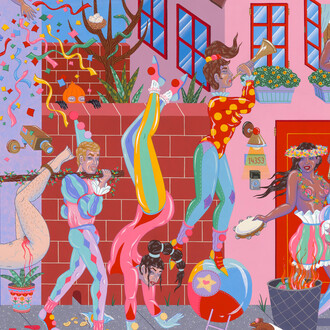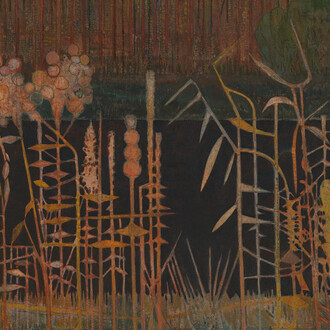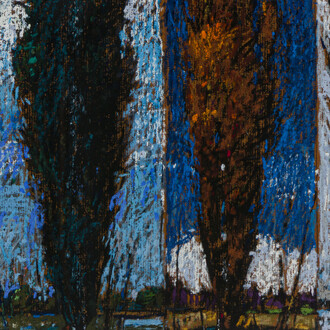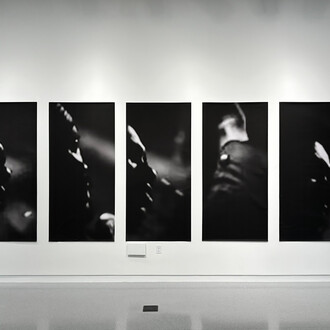[siccer] is an interdisciplinary project and immersive installation by artist and choreographer Will Rawls (b. 1978, Boston, MA), who is based between Los Angeles and New York. Marking Rawls’ most significant institutional presentation to date, [siccer] uses dance, stop-motion animation, and sound to investigate the role of media in documenting, exploiting, and erasing the Black body.
Adopting the techniques and technologies associated with the cinema and the stage, Rawls’ work challenges divisions between the living, the rehearsed, and the performed. Produced with stop-motion animation, [siccer] features an all-Black cast of performers in various states of motion and capture. At once fragmented and continuous, the performers’ gestures glitch in and out of focus across a scaffolding of chroma green frames reminiscent of the green screens commonly associated with film production. While the green screen is traditionally meant to disappear, in [siccer], the screen becomes the setting for both performer and visitor. In this refusal to remain fixed, Rawls recontextualizes how racialized subjects navigate forced states of invisibility. And, as Kermit the Frog reminds us, “it’s not easy being green.”
The project’s title is inspired by the Latin adverb sic, often used within brackets to indicate incorrect spelling within a citation. Through this titular reference, [siccer] illuminates the ways in which Black subjectivity resists standard Western forms of “correction,” suggesting instead a way of being that is both iterative and endlessly becoming. In an image-saturated world wherein our technologies and identities are inextricably intertwined, [siccer] points to the trap of the ever-present camera—echoed in the repeated snaps that resound from the installation’s soundscape—and the intensive labor of becoming an image. This exhaustion of being held in a constant state of fugitivity is further emphasized by the cattails scattered throughout the gallery, which allude to the environment of the swamp. Neither land nor water, but a territory that exists between both landscapes, the swamp represents an ecological site of transformation. For Black and Indigenous people in particular, the swamp has historically served as a space of refuge, liberation, and self-reclamation.
Embracing the liminality of the swamp, Rawls—together with performers Holland Andrews, keyon gaskin, jess pretty, Katrina Reid, and Jeremy Toussaint-Baptiste—explores the limits and possibilities of gesture and language to speculate on collective strategies of narrating the world, uncorrected.
![Will Rawls, [siccer], exhibition view. Courtesy of ICA LA](http://media.meer.com/attachments/30439bab9a7bb19f0b914501f57c2e1f92ae06e8/store/fill/1090/613/2fb94b9e92d694b1a4edd0099a9ceb5b5bf3baddfeb061642df3662e6224/Will-Rawls-siccer-exhibition-view-Courtesy-of-ICA-LA.jpg)

![Will Rawls, [siccer], exhibition view. Courtesy of ICA LA](http://media.meer.com/attachments/fe68ebcc49c14d8f6f5d3a5ef2d5d28b50670a3b/store/fill/410/615/e70846472553ad6363f9c5520702beddba16cf8299147f8d06455f2d8d72/Will-Rawls-siccer-exhibition-view-Courtesy-of-ICA-LA.jpg)
![Will Rawls, [siccer], exhibition view. Courtesy of ICA LA](http://media.meer.com/attachments/eb4fff0e97f7aef4a425f9c1ea445917ceda2bbc/store/fill/465/698/bb80a52a585c97e29ea8d1745733926869525c2993c56d66e0c7fbab947c/Will-Rawls-siccer-exhibition-view-Courtesy-of-ICA-LA.jpg)
![Will Rawls, [siccer], exhibition view. Courtesy of ICA LA](http://media.meer.com/attachments/89efc45593efbf105caa975487b66e263d311460/store/fill/465/698/c594f5669ec7d136577207d9a15620d7a64f66d801a10121b5d759726701/Will-Rawls-siccer-exhibition-view-Courtesy-of-ICA-LA.jpg)











